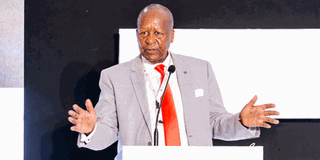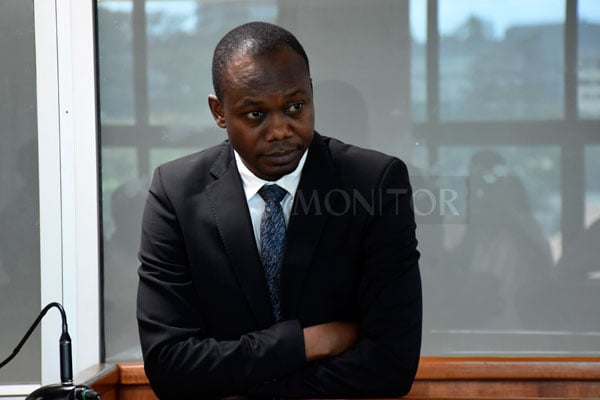Kaijuka: How NDP IV will propel extractives

Mr Richard Henry Kaijuka, the chairman of the Board of Trustees for the Uganda Chamber of Mines and Petroleum. PHOTO/FILE
What you need to know:
- On July 31, during the Uganda Chamber of Mines and Petroleum (UCMP) Annual General Meeting, two members from the Chamber's Governing Council were elevated to the Board: Mr Patrick Mweheire of Standard Bank Group and Mr Nicholas Ecimu from S&L Advocates.
- Prosper magazine’s Betty Ndagire interviewed Mr Richard Henry Kaijuka, the chairman of the Board of Trustees for the Uganda Chamber of Mines and Petroleum, regarding these leadership changes and the broader extractive sector.
Bring us to speed on what the new changes in leadership at the Chamber entail.
To begin with, Uganda Chamber of Mines and Petroleum (UCMP) has two Boards: the Board of Trustees, which I chair, and the Governing Council, which reports to us. Our members have elevated Mr Mweheire, who has served as Chairman of the Governing Council for three years, to the Board of Trustees. We also welcomed Mr Ecimu who has been a member of the Council for eight years. Both individuals bring a wealth of expertise in management, particularly related to our extractive sectors of mining and petroleum. Members elected Mr Aggrey Ashaba as the new chairman of the Council.
Could you highlight UCMP’s current strategic priorities in the extractive sector?
Our key strategic priorities focus on advocating for policies that support the growth and investment of the mining and petroleum sectors, fostering stakeholder engagement, and promoting sustainable development. We are also rebranding the Chamber to expand its scope to include energy, aiming to stimulate sectoral growth and enhance private sector and economic development. Global Climate Change challenges dictate that we focus on green energies and related critical transit minerals.
As an influential private sector body, how would you advise the government to increase mineral production and productivity to harness economic opportunities?
We are optimistic about the government’s direction under National Development Plan (NDP) IV, particularly about the Mining and Minerals Act 2022, which addresses key challenges in the sub-sector, such as delays in development and revenue losses due to speculators. As global demand for minerals rises, investment in mineral development will help lower production costs, increase returns on investment, and expand the availability of locally manufactured products such as cement, iron, and steel.
The government should prioritise investing in exploration, quantifying and mapping priority minerals such as iron ore, copper, and phosphates, monitoring mining operations, establishing and capitalising the National Mining Company, licensing artisanal miners while scaling up the biometric registration system, and fast-tracking the development of industrial water facilities.
The FY2024/25 budget for extractives rose to Shs961 billion.
If you were to advise the government on prioritising investments in the extractive sector, which industry would you emphasize?
Both the mining and petroleum sectors are vital for advancing Uganda’s economic future. The FY2024/25 budget saw an increase in funding for the extractive sector from Shs501 billion last year to Shs961 billion this year. This funding is intended to accelerate the development of key projects such as the East African Crude Oil Pipeline (EACOP) and the refinery on the side of oil, advance the quantification and market studies of minerals to attract investors, and operationalise the National Mining Company on the side of minerals. This investment will promote sector growth, enhance infrastructure, and create more job opportunities.
The mining sector's contribution to the national Gross Domestic Product (GDP) grew from 0.3 percent in FY2009/2010 to 2.2 percent in FY2022/23, and with strategic investment, it could go beyond the 7 percent levels seen in the 1950s and 1960s. As for oil and gas, every $1 (Shs3,715) invested is expected to generate $0.6 (Shs2,229.5) in indirect GDP growth. With $20 billion being invested in the sector’s current development phase, a direct investment of $14 billion—29 percent of Uganda's GDP—could lead to an indirect GDP growth of $8.5 billion (18 percent of GDP) when production begins. The oil and mineral sectors have the potential to sustain Uganda’s economy for generations to come.
What measures is the Chamber taking to ensure that the benefits of the extractive sector are equitably distributed across Uganda?
We have been proactive in advocating for policies that ensure fair distribution of the benefits from the sector, including promoting local content requirements and pushing for transparency in revenue management.
In terms of minerals, Uganda is richly endowed with vast, untapped deposits of gold, copper, high-grade tin, tungsten/wolfram, salt, beryllium, cobalt, kaolin, iron ore, glass sand, vermiculite, phosphates (for fertilisers), uranium, rare earth elements, and more. Uganda must learn to focus on serious mineral exploration so that we have quantified mineral resource estimates. This will attract investment otherwise the bulk of our minerals will remain underground. These resources will remain valuable even after oil reserves are depleted.
In the oil sector, several Ugandan companies have already benefited by securing contracts for goods and services. So far, approximately US$7.5 billion has been invested in the oil and gas sub-sector to support the development phase leading up to commercial production, with about US$1.8 billion going to Ugandan companies. This has created numerous jobs and opened up a variety of opportunities.
What are the key challenges currently facing Uganda’s mining sector, and how is the government addressing them?
Uganda’s mining sector faces significant challenges such as poor infrastructure, regulatory complexities, environmental issues, and weak institutional frameworks. To overcome these, we have advised the government to improve infrastructure, including roads and transportation links to mining areas. We support the government’s efforts to simplify regulations, making the sector more attractive to investors while maintaining strong environmental safeguards.
The question of balancing the need for mineral resource extraction with environmental conservation and economic growth...what is your view?
Balancing resource extraction with environmental conservation is essential for driving economic growth. Industry players have assured us of their commitment to enforcing stringent environmental regulations to minimise the negative impacts of mining activities. This includes thorough Environmental Impact Assessments (EIAs) and adherence to best practices in waste management and land rehabilitation. We also emphasize the importance of community engagement, ensuring that local populations benefit from mining through job creation, infrastructure improvements, and community development projects.
Last but not least, what role do you see technology and innovation playing in the future of Uganda’s mining sector?
Technology and innovation will be crucial in shaping the future of Uganda’s mining sector, particularly as we move to implement NDP IV running from 2025-2030. Advances in exploration techniques, such as remote sensing and geophysical imaging, will enhance our ability to discover and evaluate mineral deposits more efficiently. Furthermore, innovations in mining practices, including automation and data analytics, will boost productivity and safety while minimising environmental harm. Adopting these technologies will help Uganda maximise resource extraction and ensure the sector’s long-term sustainability.





